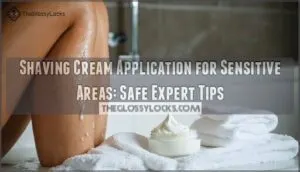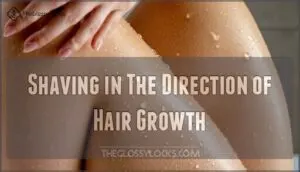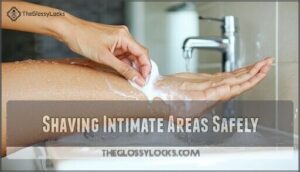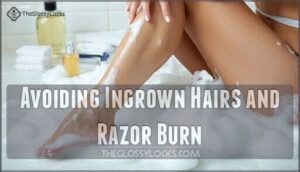This site is supported by our readers. We may earn a commission, at no cost to you, if you purchase through links.

Start by softening the hair with warm water, then apply a thin layer of shaving cream using gentle circular motions. Don’t rush – let it sit for a minute to create that protective barrier between your razor and skin.
Always shave in the direction of hair growth to minimize irritation, and rinse with cool water afterward. The secret lies in preparation and choosing the right products for your skin’s unique needs.
Table Of Contents
- Key Takeaways
- Choosing The Right Shaving Cream
- Shaving Cream Alternatives
- Safe Shaving Practices
- Shaving Sensitive Areas
- Shaving Cream and Skin Conditions
- Aftershave and Shaving Cream
- Tips for a Smooth Shave
- Frequently Asked Questions (FAQs)
- Can you use shaving cream on intimate areas?
- What is the 3:1:1 rule for shaving cream?
- Which shaving cream is best for the pubic area?
- Can I use magic shave cream on my pubic area?
- What is the best shaving cream for shaving pubic area?
- Can I use shaving cream as lube?
- How often should I shave sensitive areas to avoid irritation?
- Can I use shaving cream on sunburned or damaged skin?
- What are the benefits of using a shaving brush on sensitive areas?
- Are there any specific shaving techniques for sensitive skin types?
- Conclusion
Key Takeaways
- Choose gentle, fragrance-free formulas – You’ll want products with soothing ingredients like aloe vera or oat extract, while avoiding harsh chemicals, alcohol, and artificial fragrances that can irritate delicate skin.
- Prepare your skin properly before shaving – You should soften hair with warm water for 3-5 minutes, then apply a thin layer of cream using gentle circular motions, and let it sit for a minute to create a protective barrier.
- Always shave with the grain using light pressure – You’ll reduce irritation and prevent ingrown hairs by following your hair’s natural growth direction with short, gentle strokes, rather than aggressive scraping motions.
- Focus on post-shave care to prevent irritation – You need to rinse with cool water immediately after shaving, then apply fragrance-free moisturizer while your skin’s still damp, to maintain hydration and repair your skin’s barrier.
Choosing The Right Shaving Cream
You’ll want to pick a shaving cream that matches your skin’s needs, especially if you notice redness, burning, or bumps after shaving.
The right formula with gentle ingredients can make the difference between a comfortable shave and days of irritation.
Identifying Sensitive Skin Types
Recognizing your skin type prevents painful shaving mishaps. Sensitive skin shows clear warning signs that demand attention and specialized shaving cream for sensitive skin.
Watch for these Redness Indicators and Post-Shave Signs:
Your skin’s warning signals demand immediate attention – listen before it’s too late.
- Persistent redness that won’t fade after shaving
- Vessel Visibility showing tiny blood vessels under your skin
- Stinging or burning when products touch your face
- Discomfort Frequency increasing with each shave
- Bumps and irritation in freshly shaved areas
These Skin Reactions signal skin sensitivity requiring gentler products. Subjective symptoms like stinging are common. Understanding your skin conditions helps you choose appropriate skin types care.
Key Ingredients for Sensitive Skin
Look for shaving cream for sensitive skin with aloe vera for soothing relief and glycerin benefits like moisture retention.
Hyaluronic acid plumps skin while natural oils create protective barriers.
Fragrance-free options prevent reactions that turn your morning routine into a red, angry mess.
For a wider selection, consider browsing fragrance-free options online.
These shaving cream ingredients work together, making shaving sensitive areas comfortable rather than painful.
Avoiding Irritating Ingredients
When selecting shaving cream for sensitive areas, avoid these skin irritants. Fragrance-free formulas prevent reactions, while alcohol alternatives maintain moisture. Skip sulfates that strip natural oils and parabens linked to allergic responses.
Here are 5 ingredients that spell trouble for sensitive skin:
- Artificial fragrances – Over 3,000 hidden chemicals can trigger painful reactions
- Sulfates (SLS/SLES) – Strip away your skin’s protective barrier, causing dryness
- Parabens – Hormone disruptors that increase allergy risks substantially
- Synthetic dyes – Colorants that cause contact dermatitis in sensitive areas
- Alcohol-based formulas – Create excessive dryness and burning sensations
Natural ingredients offer shaving irritation relief without compromising your comfort. Some products also contain harmful ethanolamines that may cause skin irritation.
Shaving Cream Alternatives
You don’t always need traditional shaving cream to get a smooth, comfortable shave on sensitive areas.
Common household items like baby oil, coconut oil, hair conditioner, and lotion can work just as well while being gentler on delicate skin.
Using Baby Oil for Shaving
Baby oil transforms your shaving routine into a silky-smooth experience.
Transform your daily shave from harsh scraping into pure silk luxury with just a few drops.
This gentle alternative offers three key advantages:
- Creates a protective barrier – Mineral oil locks in moisture while your razor glides effortlessly
- Reduces irritation risk – Fragrance-free formulas won’t trigger reactions on sensitive skin
- Provides crystal-clear visibility – You’ll see exactly where you’re shaving
Apply just 2-3 drops after soaking with warm water for ideal baby oil benefits.
Many people find baby oil application provides excellent results.
Coconut Oil for Sensitive Areas
Coconut oil’s natural lubricating properties make it a gentle alternative for sensitive areas.
Its lauric acid provides antibacterial benefits while creating a protective barrier that reduces razor burn.
However, coconut oil can clog pores on acne-prone skin.
Apply a thin layer, rinse your razor frequently, and consider patch testing before use on intimate areas.
Many users find coconut oil intimate products beneficial.
Hair Conditioner as a Shaving Aid
Hair conditioner offers surprising benefits as a shaving cream alternative for sensitive areas.
Its moisturizing properties create excellent slip while softening hair for easier cutting.
- Hair Softening: Conditioner’s emollients break down hair’s protective layer, making removal gentler
- Skin Hydration: Rich formulas prevent razor drag and maintain moisture during shaving
- Cost Comparison: Using existing conditioner saves money compared to specialized shaving products
- Application Techniques: Apply generously, let sit briefly, then shave with smooth strokes
This budget-friendly option provides the slip you need without harsh chemicals found in traditional products.
Lotion for Shaving Sensitive Skin
Another gentle alternative you’ll find effective is using lotion for shaving sensitive areas.
This method works particularly well when you need extra skin hydration and irritation prevention.
- Choose fragrance-free lotion ingredients like glycerin or aloe vera to minimize reactions
- Apply using gentle application techniques – spread a thin layer evenly across damp skin
- Enjoy post-shave benefits including reduced redness and enhanced moisture retention
Rich, non-greasy formulas create excellent razor glide while protecting delicate skin from nicks and burns.
For enhanced lubrication, consider options that offer moisturizing properties.
Safe Shaving Practices
Safe shaving practices protect your skin from irritation and injury while achieving smooth results.
You’ll need proper preparation, gentle application techniques, and careful attention to sensitive areas to avoid razor burn and ingrown hairs, ensuring smooth results.
Pre-Shaving Preparation
Preparing your skin properly sets the stage for a comfortable shave.
Start by soaking sensitive areas in warm water for 3-5 minutes to achieve effective hair softening.
This simple shaving preparation technique opens pores and makes hair easier to cut.
Consider gentle exfoliation benefits the night before, but skip harsh scrubs on delicate skin.
Pre-shave products aren’t always necessary—sometimes warm water does the trick perfectly.
Applying Shaving Cream or Alternatives
Once you’ve prepped your skin, it’s time to apply your chosen product.
Use your fingertips to work shaving cream sensitive skin formulas into a rich lather, creating even cream distribution across sensitive areas.
Cream application techniques for ideal results:
- Apply using circular motions with clean fingers rather than a brush for gentler contact
- Start with a quarter-size amount and add more as needed
- Let the product sit for 2-3 minutes to soften hair follicles
- Focus on alternative application methods like patting rather than rubbing harsh areas
Shaving in The Direction of Hair Growth
Once you’ve applied your shaving cream for sensitive skin, map your hair growth direction by gently running fingers across the area.
Shave with gentle strokes following the natural hair growth pattern to minimize irritation and make certain smooth razor glide.
This technique prevents ingrown hairs and reduces friction on sensitive areas, making each pass more comfortable and effective, ensuring a smooth razor glide.
Rinsing and Moisturizing After Shaving
Once you’ve shaved with the grain, Cold Water Rinse your skin thoroughly to remove leftover cream and close pores.
This simple step helps prevent skin irritation and prepares your sensitive areas for the next phase of postshave care.
Patting Dry with a clean towel is your best friend here—no aggressive rubbing that’ll turn your skin red.
Think of your skin like a delicate flower after shaving; it needs gentle treatment to bloom beautifully.
Essential moisturization steps for ideal Barrier Repair:
- Apply Fragrance-Free Lotion while skin remains slightly damp
- Choose products with aloe vera or chamomile for sensitive skin
- Massage gently in circular motions without pressing hard
- Focus extra attention on areas prone to dryness
- Wait five minutes before getting dressed
Remember, Hydration Importance can’t be overstated—your skin’s like a sponge that’s just been through a workout and needs proper rehydration.
Shaving Sensitive Areas
Shaving sensitive areas requires extra care and the right technique to prevent irritation and discomfort.
You’ll want to choose gentle products and follow specific steps to protect delicate skin while achieving a smooth, safe shave.
Shaving Intimate Areas Safely
Navigating intimate areas requires extra care and the right approach.
Choose pH-balanced, fragrance-free shaving cream for intimate areas to prevent post-shave irritation.
Always trim longer hair first, then hydrate skin with warm water for 3-5 minutes before applying your chosen product.
| Preparation Step | Recommended Action | Why It Matters |
|---|---|---|
| Trimming | Use scissors or trimmer first | Prevents razor clogging |
| Hydration | Soak in warm water 3-5 minutes | Softens hair and skin |
| Product Choice | pH-balanced, fragrance-free cream | Reduces skin sensitivity tests needs |
| Application | Light, even coverage | Creates protective barrier |
When shaving sensitive areas, pull skin taut and use short, gentle strokes following hair growth direction.
This technique substantially reduces razor burn relief needs and supports ingrown hair prevention.
Replace blades after 5-7 uses to maintain sharpness and minimize infection risk.
Using Shaving Cream on Sensitive Spots
Now you’re ready to tackle those tricky spots that need extra TLC. When applying shaving cream for intimate areas, less is more – a thin layer provides protection without clogging sensitive skin.
Product patch testing becomes your best friend here, especially for first-time users. Your skin’s like a personalized roadmap – what works for your friend mightn’t work for you.
Here’s your sensitive area shaving game plan:
- Map your sensitive zones before starting – know where your skin reacts most
- Test new products on a small patch 24 hours before full application
- Apply with gentle fingertips instead of rough washcloths or loofahs
- Focus on pressure point shaving areas like bikini lines and underarms
- Keep cream application tips simple – circular motions work best for even coverage
Sensitive skin mapping helps you identify which spots need extra cream and which areas prefer minimal product. Remember, shaving cream for pubic area application should feel comfortable, not irritating.
Avoiding Ingrown Hairs and Razor Burn
Exfoliation benefits start with gentle scrubbing one day before shaving sensitive areas.
Use proper razor angles and maintain blade sharpness to prevent tugging. Hydration importance can’t be overstated—moisturize skin beforehand.
Shave with the grain using short strokes for razor burn prevention.
Post-shave care includes cold water rinses and fragrance-free moisturizer for effective ingrown hair treatment.
Shaving Cream for Pubic Area
Selecting the right shaving cream for pubic area grooming can make all the difference in your comfort and results.
Your bikini line shaving routine deserves products specifically designed for these delicate zones.
Here’s your roadmap to smooth, irritation-free pubic hair removal:
- Choose fragrance-free formulas – Skip scented products that can cause stinging or burning sensations
- Apply generous amounts – Don’t skimp on cream application tips; thick coverage prevents nicks and cuts
- Pick quality razors – Sharp blades reduce tugging, making razor choice matters for ingrown hair prevention
- Follow with gentle care – Your soothing aftercare routine should include alcohol-free moisturizers for sensitive areas
Shaving Cream and Skin Conditions
If you have acne, rosacea, or other skin conditions, choosing the right shaving cream becomes even more critical for your comfort and skin health.
These conditions require special attention to ingredients and application techniques to prevent flare-ups and irritation.
Shaving With Acne-Prone Skin
Your acne-prone skin deserves extra care during shaving.
Choose acne-safe creams with non-comedogenic formulas to prevent clogged pores. Practice gentle exfoliation before shaving and maintain strict razor cleaning between strokes.
Focus on inflammation control through proper post-shave care with fragrance-free moisturizers.
| Do This | Avoid This |
|---|---|
| Use non-comedogenic shaving cream | Heavy, pore-clogging formulas |
| Clean razor after each stroke | Dirty, bacteria-laden blades |
| Apply gentle pressure | Aggressive scraping motions |
| Moisturize with oil-free products | Thick, greasy aftercare |
| Shave with hair growth direction | Against-the-grain techniques |
Rosacea and Shaving Cream
Rosacea makes your face a sensitive battlefield where the wrong shaving cream can trigger painful flare-ups. Fragrance-free, alcohol-free shaving cream for rosacea becomes your best ally in this daily challenge.
Here are 5 essential tips for choosing the right product:
- Select cream ingredients like aloe vera, glycerin, and jojoba oil that soothe rather than irritate
- Avoid rosacea triggers including menthol, eucalyptus, artificial fragrances, and sodium lauryl sulfate
- Try product alternatives like non-foaming cleansers from CeraVe or specialized sensitive skin formulas
- Master your shaving technique by using single-blade razors and shaving with the grain, not against it
- Focus on post-shave care with barrier-repair creams that reduce redness and support skin recovery
Non-lathering creams work better than aerosol foams for sensitive areas prone to inflammation.
Managing Excessive Dryness
Combating excessive dryness when shaving sensitive areas requires smart hydration techniques and the right products.
Choose moisturizers rich in emollients like shea butter for barrier repair and lipid replenishment.
Humectant options such as glycerin draw moisture to your sensitive skin.
Apply thick creams before and after shaving to lock in skin moisturizing benefits and prevent uncomfortable dryness.
Photosensitivity and Shaving
When you have photosensitive skin, shaving can sometimes trigger unwanted reactions. Your skin becomes extra vulnerable after hair removal, making Post-Shave Protection vital against UV Exposure and other Photosensitivity Triggers.
Proper preparation guarantees skin is ready for shaving.
To protect your skin, consider the following steps:
- Choose a shaving cream with built-in SPF to shield sensitive skin from harmful rays
- Apply broad-spectrum sunscreen immediately after shaving sensitive areas to prevent sunburned skin
- Time your shaving routine for evening hours, minimizing Medication Effects and reducing photosensitivity risks
Aftershave and Shaving Cream
You’ll want to understand how aftershave and shaving cream work together to protect your sensitive skin after shaving.
The right combination can prevent irritation, reduce redness, and keep your skin healthy in delicate areas.
Benefits of Using Aftershave
Aftershave works like your skin’s best friend after razor burn strikes.
It’ll reduce irritation and prevent infection while delivering essential moisturization to sensitive areas.
Quality aftershave products soothe razorburn with healing ingredients, plus fragrance benefits that keep you feeling fresh.
Your skin gets the TLC it deserves.
Choosing The Right Aftershave
When selecting aftershave for sensitive areas, prioritize alcohol-free options that won’t sting or cause skin irritation.
Look for soothing ingredients like aloe vera, chamomile, or glycerin that promote skin hydration while reducing irritation.
Consider your scent preferences—fragrance-free formulas work best for reactive skin.
A quality aftershave may contain glycerin and aloe to further soothe the skin.
These skincare products should complement your shaving routine, not fight against it, by providing skin hydration.
Can I Use Shaving Cream as Lube?
**Shaving cream as lube?
Bad idea.
Shaving cream contains harsh chemicals, fragrances, and surfactants that disrupt vaginal pH and cause skin irritation in intimate areas.
These ingredients weren’t designed for sensitive mucous membranes and can lead to burning, redness, or infections.
Partner preferences aside, lube alternatives like water-based lubricants are safer.
Skip the spermicide concerns and shaving cream risks – your body deserves better protection.
Alternatives to Aftershave
Your skin doesn’t need commercial aftershave to feel refreshed. Natural Soothers work just as well without harsh chemicals that cause skin irritation in sensitive areas.
DIY Aftershaves using simple ingredients offer gentle moisturization while supporting your skin’s natural healing process.
- Aloe vera gel – Pure aloe provides instant cooling relief and reduces redness after shaving
- Witch hazel toner – This natural astringent minimizes pores while delivering Toner Benefits without alcohol sting
- Coconut oil blend – Mix with tea tree oil for antimicrobial protection and deep moisturization
- Hydrating Balms – Homemade shea butter balms create protective barriers against environmental irritants
- Oil Alternatives – Jojoba or sweet almond oil mimic skin’s natural sebum for perfect skin soothing
Tips for a Smooth Shave
Achieving a smooth, irritation-free shave in sensitive areas requires attention to detail and the right techniques.
You’ll want to focus on proper preparation, quality tools, and smart storage habits to minimize discomfort and maximize results.
This approach will help ensure that you achieve the best possible outcome, with minimal discomfort.
Exfoliating Before Shaving
Proper preparation sets the stage for a comfortable shave. Exfoliating before shaving removes dead skin cells and lifts trapped hairs, creating a smoother canvas for your razor.
This step reduces friction and helps prevent those pesky ingrown hairs that can plague sensitive skin.
Here’s how to exfoliate safely for sensitive areas:
- Product Selection: Choose gentle exfoliating methods like soft washcloths, sugar scrubs, or chemical exfoliants with mild AHAs for sensitive skin types.
- Timing Matters: Exfoliate 24-48 hours before shaving, not right before. This prevents over-stimulating already delicate skin.
- Exfoliation Methods: Use light, circular motions with minimal pressure. Think gentle massage, not aggressive scrubbing.
- Sensitive Exfoliation: Focus on areas prone to ingrown hairs, but avoid broken or irritated skin completely.
The exfoliation benefits include smoother razor glide and reduced post-shave bumps, making your gentle shaving techniques more effective.
Using a Sharp Razor Blade
After exfoliating, you’ll want a sharp blade that cuts cleanly through hair without tugging.
Dull blades drag across sensitive skin, creating razor burn and irritation. Replace disposable razors after 5-7 uses for best performance when shaving sensitive areas.
To maintain blade sharpness, store razors properly in a dry environment.
| Blade Factor | Impact on Sensitive Skin |
|---|---|
| Blade Sharpness Impact | Sharp blades cut hair cleanly, reducing drag and irritation |
| Multi-Blade Advantages | Multiple blades distribute pressure, minimizing skin contact |
| Blade Angle Matters | Proper 30-degree angle prevents nicks and cuts |
| Replacing Blades Often | Fresh blades every 5-7 shaves prevent bacterial buildup |
| Razor Burn Prevention | Sharp blades require less pressure, reducing inflammation |
Shaving in a Well-Lit Area
Good lighting isn’t just helpful—it’s your best friend when shaving sensitive areas.
You’ll spot every contour and avoid those "oops" moments that nobody wants to explain later.
Visibility Benefits make all the difference for shaving tips in intimate areas.
Shadow Reduction prevents you from missing spots or accidentally nicking yourself.
When you can clearly see what you’re doing, Spotting Irritation becomes easier, helping you adjust your technique before problems develop.
Consider these Lighting Types for ideal results:
- Natural daylight from a window provides the most accurate view
- LED bathroom lights offer consistent, bright illumination
- Vanity lights with multiple bulbs eliminate harsh shadows
Avoiding Missed Spots in the pubic area requires proper illumination—you can’t shave what you can’t see clearly.
Storing Shaving Cream Properly
Temperature control keeps your shaving cream effective longer—store containers in cool, dry spots away from bathroom humidity.
Heat and moisture can break down ingredients, reducing performance for sensitive areas like your pubic area.
Choose airtight container types for travel storage to preserve shelf life.
Your intimate areas deserve fresh, properly stored products that won’t cause irritation.
Frequently Asked Questions (FAQs)
Can you use shaving cream on intimate areas?
You can use specially formulated shaving cream on intimate areas, but choose fragrance-free, hypoallergenic products designed for sensitive skin. Avoid harsh chemicals and always test on a small area first.
What is the 3:1:1 rule for shaving cream?
I’m not familiar with a specific "3:1:1 rule" for shaving cream. This isn’t a standard grooming guideline I can verify. Could you clarify what you’re referring to?
Which shaving cream is best for the pubic area?
Like choosing the right fabric for delicate lingerie, you’ll want fragrance-free, hypoallergenic shaving cream with aloe vera or oatmeal.
Look for "sensitive skin" labels and avoid alcohol, menthol, or harsh chemicals that’ll irritate your most tender areas, using hypoallergenic products to minimize discomfort.
Can I use magic shave cream on my pubic area?
Magic shave cream can work for your pubic area, but proceed carefully.
It’s formulated for coarse hair but contains strong chemicals that might irritate sensitive skin there.
Test on a small area first.
What is the best shaving cream for shaving pubic area?
Exploring your intimate landscape requires the right compass—gentle, fragrance-free shaving cream designed for sensitive skin.
Choose products with aloe vera, glycerin, or oat extracts.
Avoid harsh chemicals like sulfates and alcohol that’ll leave you uncomfortable.
Can I use shaving cream as lube?
No, you shouldn’t use shaving cream as lube.
It’s not designed for intimate contact and can cause irritation, infections, or disrupt natural pH balance.
Use proper personal lubricants instead for safety.
How often should I shave sensitive areas to avoid irritation?
How often should you shave to keep things comfortable down there?
For sensitive areas, wait 2-3 days between sessions.
Daily shaving irritates delicate skin, causing bumps and redness.
Give your skin time to recover between shaves for smoother results, and remember to wait to avoid irritating delicate skin.
Can I use shaving cream on sunburned or damaged skin?
You shouldn’t use shaving cream on sunburned or damaged skin. Wait until your skin heals completely before shaving. The chemicals can worsen irritation and delay recovery. Consider gentle moisturizers instead.
What are the benefits of using a shaving brush on sensitive areas?
A shaving brush is like a gentle gardener’s touch, lifting hair for smoother cuts while distributing cream evenly.
It exfoliates dead skin, reduces irritation, and creates rich lather that protects delicate areas better than hands alone, providing a more comfortable shaving experience with gentle care.
Are there any specific shaving techniques for sensitive skin types?
Gentle preparation is everything for delicate skin.
Softening hair with warm water for three minutes, then applying cream in circular motions, is a crucial step.
Always shave with the grain using light pressure and sharp blades.
Conclusion
Maria learned the hard way that using her regular body wash as makeshift shaving cream left her with painful razor burn that lasted days.
Proper shaving cream application for sensitive areas doesn’t have to be complicated, but it does require the right approach. You’ve got the knowledge now to choose gentle formulas, prepare your skin properly, and shave safely.
Remember to take your time, use light pressure, and always moisturize afterward. With these techniques, you’ll achieve smooth results without the irritation that comes from rushing or using harsh products.
- https://gillette.com/en-us/shaving-tips/shaving-science/why-use-shaving-cream
- https://www.vitaman.com.au/blogs/v-male/what-does-shaving-cream-do-and-why-you-need-to-use-it
- https://jointhebx.com/blogs/skin-care/the-benefits-of-using-glazed-shaving-cream-for-sensitive-skin
- https://health.howstuffworks.com/skin-care/men/shaving-tips/shaving-cream-for-sensitive-skin.htm
- https://cremocompany.com/products/sensitive-skin-shave-cream















